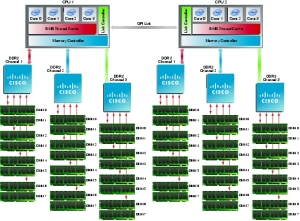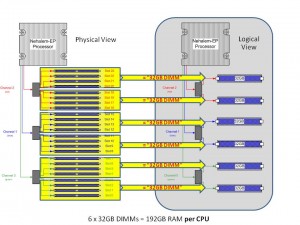A recent article by SearchDataCenter.com titled Top Ten Data Center Trends of 2011, predicts that Cisco UCS blade servers will grab mega market share and inspires more converged infrastructure products. Continue reading
Tag Archives: UCS
Cisco Releases UCS Firmware 1.4
As I’m sure most of you already know, Cisco has released an anticipated update to the firmware for UCS. Of the dozens of enhancements that were added or modified, perhaps one of the most interesting is Cisco’s integration of their rack-based “C-Series” line into the UCS Platform. This provides users with a single interface to manage both their rack and their blade server platforms. Instead of re-creating the wheel, I encourage you take a few minutes to read up on all the goodness from M. Sean McGee’s site at http://www.mseanmcgee.com/2010/12/cisco%e2%80%99s-stocking-stuffer-for-ucs-customers-firmware-release-1-41/
hp warranty check
groupon las vegas
gold price history
dallas mavericks schedule
art of war quotes
Still Confused About Cisco’s Blade Market Share
I recently received a comment on my previous post concerning Cisco’s market share (“What’s the Truth About Cisco’s Market Share“) which has me more confused. The comment admits that Cisco has not released any market share data to IDC, but that when you look at the Cisco Q1 2010 Earnings Call and compare it to IDC’s findings of the overall industry you should be able to derive conclusions from there. That’s where it gets confusing. Continue reading
A Post from the Archive: “Cisco UCS vs IBM BladeCenter H”
It’s always fun to take a look at the past, so today I wanted to revisit my very first blog post. Titled, “Cisco UCS vs IBM BladeCenter H”, I focused on trying to compare Cisco’s blade technology with IBM’s. Was I successful or not – it’s up to you to decide. This article ranks at #7 in all-time hits, so people are definitely interested. Keep in mind this post has not been updated to reflect any changes in offering or technologies, it’s just being offered as a look back in time for your amusement. Here’s how the blog post began: Continue reading
Cisco UCS vs HP Virtual Connect
My friend, M. Sean McGee, wrote up a great blog post in April that deserves revisiting titled, “The State of Statelessness: Cisco UCS vs. HP Virtual Connect“. In the write-up, he discusses Cisco how Unified Computing System (UCS) blade servers are “stateless” and use “UCS Service Profiles”. He identifies 96 server settings that can be handled via the UCS Service Profile vs 12 server settings with HP’s Virtual Connect Server Profile. It is a great read, so I encourage you to take a few minutes and see if you agree with what he writes.
defined benefit plan
megabus promotion code
north kansas city hospital
duns number lookup
new york state department of education
What is the Truth About Cisco’s Blade Server Market Share?
What is Cisco’s blade server market share? That seems to be the mystery question that no one can really answer. The previous IDC quarterly worldwide server report mentioned nothing about Cisco, yet readers and bloggers alike claim Cisco is #3, so what IS the true answer? Continue reading
Blade Server Q&A
I’ve been getting some questions via email and I’ve seen some questions being asked in my LinkedIn group, “Blade Server Technologies” so I thought I’d take a few minutes in today’s post to answer these questions, as well as get your feedback. Feel free to post your thoughts on these questions in the comments below. Continue reading
Cisco Announces 32 DIMM, 2 Socket Nehalem EX UCS B230-M1 Blade Server
 Thanks to fellow blogger, M. Sean McGee (http://www.mseanmcgee.com/) I was alerted to the fact that Cisco announced on today, Sept. 14, their 13th blade server to the UCS family – the Cisco UCS B230 M1.
Thanks to fellow blogger, M. Sean McGee (http://www.mseanmcgee.com/) I was alerted to the fact that Cisco announced on today, Sept. 14, their 13th blade server to the UCS family – the Cisco UCS B230 M1.
This newest addition performs a few tricks that no other vendor has been able to perform. Continue reading
384GB RAM in a Single Blade Server? How Cisco Is Making it Happen (UPDATED 1-22-10)

- Cisco UCS B250 M1 Extended Memory Blade Server
Cisco’s UCS server line is already getting lots of press, but one of the biggest interests is their upcoming Cisco UCS B250 M1 Blade Server. This server is a full-width server occupying two of the 8 server slots available in a single Cisco UCS 5108 blade chassis. The server can hold up to 2 x Intel Xeon 5500 Series processors, 2 x dual-port mezzanine cards, but the magic is in the memory – it has 48 memory slots.
This means it can hold 384GB of RAM using 8GB DIMMS. This is huge for the virtualization marketplace, as everyone knows that virtual machines LOVE memory. No other vendor in the marketplace is able to provide a blade server (or any 2 socket Intel Xeon 5500 server for that matter) that can achieve 384GB of RAM.
So what’s Cisco’s secret? First, let’s look at what Intel’s Xeon 5500 architecture looks like.

As you can see above, each Intel Xeon 5500 CPU has its own memory controller, which in turn has 3 memory channels. Intel’s design limitation is 3 memory DIMMs (DDR3 RDIMM) per channel, so the most a traditional server can have is 18 memory slots or 144GB RAM with 8GB DDR3 RDIMM.
With the UCS B-250 M1 blade server, Cisco adds an additional 15 memory slots per CPU, or 30 slots per server for a total of 48 memory slots which leads to 384GB RAM with 8GB DDR3 RDIMM.

How do they do it? Simple – they put in 5 more memory DIMM slots then they present all 24 memory DIMMs across all 3 channels to an ASIC that sits between the memory controller and the memory channels. The ASIC presents the 24 memory DIMMs as 1 x 32GB DIMM to the memory controller. For each 8 memory DIMMs, there’s an ASIC. 3 x ASICs per CPU that represents 192GB RAM (or 384GB in a dual CPU config.) 
It’s quite an ingenious approach, but don’t get caught up in thinking about 384GB of RAM – think about 48 memory slots. In the picture below I’ve grouped off the 8 DIMMs with each ASIC in a green square (click to enlarge.)
With that many slots, you can get to 192GB of RAM using 4GB DDR3 RDIMMs– which currently cost about 1/5th of the 8GB DIMMs. That’s the real value in this server.
Cisco has published a white paper on this patented technology at http://www.cisco.com/en/US/prod/collateral/ps10265/ps10280/ps10300/white_paper_c11-525300.html so if you want to get more details, I encourage you to check it out.
Cisco’s Unified Computing System Management Software
Cisco’s own Omar Sultan and Brian Schwarz recently blogged about Cisco’s Unified Computing System (UCS) Manager software and offered up a pair of videos demonstrating its capabilities. In my opinion, the management software of Cisco’s UCS is the magic that is going to push Cisco out of the Visionary quadrant of the Gartner Magic Quadrant for Blade Servers to the “Leaders” quadrant.
The Cisco UCS Manager is the centralized management interface that integrates the entire set of Cisco Unified Computing System components. The management software not only participates in UCS blade server provisioning, but also in device discovery, inventory, configuration, diagnostics, onitoring, fault detection, auditing, and statistics collection.
On Omar’s Cisco blog, located at http://blogs.cisco.com/datacenter, Omar and Brian created two videos. Part 1 of their video offers a general overview of the Management software, where as in Part 2 they highlight the capabilities of profiles.
I encourage you to check out the videos – they did a great job with them.
